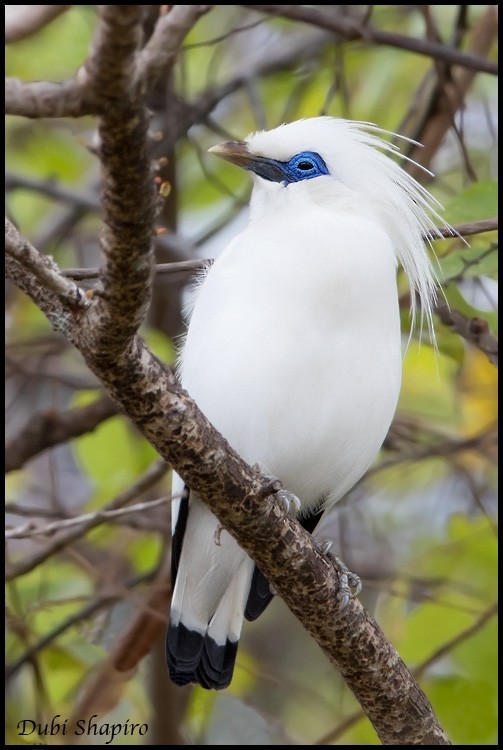Bali Myna
A species of Myna, Also known as Bali Mynah Scientific name : Leucopsar rothschildi Genus : Myna
Bali Myna, A species of Myna
Also known as:
Bali Mynah
Botanical name: Leucopsar rothschildi
Genus: Myna
Content
Description General Info
 Photo By Dubi Shapiro
Photo By Dubi Shapiro Description
The Bali myna is a medium-large bird around 25 centimetres (9.8 in) in length. It is almost wholly white with a long, drooping crest, black wing-tips and tail tip. It has a yellow bill with blue bare skin around the eyes and legs. The black-winged starling (Sturnus melanopterus), a similar species, has a shorter crest and a much larger area of black on wings and tail, plus a yellow eye-ring (without feathers) and legs. 
Size
25 cm
Life Expectancy
25 years
Nest Placement
Tree
Feeding Habits
Bali Myna is omnivorous, feeding on seeds, small and large fruits, nectar, and various insects. It consumes seeds from Sterculia foetida, fruits from species such as Lantana camara and Passiflora foetida, and figs. It also targets nectar from Erythrina, and its animal diet includes caterpillars, ants, and grasshoppers, sometimes even small reptiles.
Habitat
Bali Myna predominantly inhabits open woodland areas that feature a grassy understorey, suggesting a preference for habitats that balance tree coverage with open grassland conditions. Although present in woodland ecosystems, bali Myna typically avoids denser, closed forest environments. These habitats are part of larger ecosystems that help support the biological needs of bali Myna, including foraging, nesting, and breeding.
Dite type
Omnivorous
General Info
Feeding Habits
Bird food type
Behavior
In its natural habitat it is inconspicuous, using tree tops for cover and–unlike other starlings–usually coming to the ground only to drink or to find nesting materials; this would seem to be an adaptation to its noticeability to predators when out in the open. The Bali mynah often gathers in groups when it is young to better locate food and watch out for predators. The vocalizations are a variety of sharp chattering calls and an emphatic tweet. The Bali myna's diet includes fruit, seeds, worms and insects. 
Distribution Area
The Bali myna is restricted to the island of Bali (and its offshore islands) in Indonesia, where it is the island's only endemic vertebrate species. (An endemic subspecies, the Bali tiger, has been extinct since 1937). In 1991, the bird was designated the faunal emblem of Bali. Featured on the Indonesian 200 rupiah coin, its local name is jalak Bali (Balinese script: ᬚᬮᬓ᭄ᬩᬮᬶ). 
Species Status
The Bali myna is critically endangered, and the wild population has been close to extinction since at least 1994. As of 2015, less than 100 adults are assumed to exist in the wild, with about 1,000 believed to survive in captivity. The Bali myna is listed in Appendix I of CITES. Trade even in captive-bred specimens is strictly regulated and the species is not generally available legally to private individuals. However, experienced aviculturalists may become affiliated with captive-breeding programs, allowing them to legally keep this species. The number of captive birds bought on the black market is estimated to be twice the number of legally acquired individuals in the captive breeding programs. There are currently three locations on Bali where the birds exist in the wild: the West Bali National Park; Bali's small island of Nusa Penida and Begawan Foundation's breeding and release site at Melinggih Kelod, Payangan. 